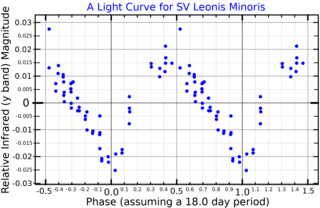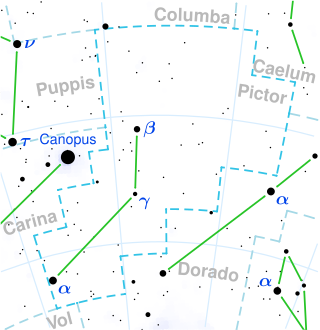
μ Sculptoris, Latinized as Mu Sculptoris, is a solitary, orange-hued star in the southern constellation of Sculptor. It is visible to the naked eye as a dim point of light with an apparent visual magnitude of +5.30. This star is located approximately 291 light years from the Sun based on parallax, and it is drifting further away with a radial velocity of +16 km/s.

46 Leonis Minoris, also named Praecipua, is the brightest star in the constellation of Leo Minor. It is of spectral class K0+III-IV and of magnitude 3.83. It is a red clump giant. Based upon parallax measurements, its distance from the Sun is approximately 99.1 light-years. It is a suspected variable with an amplitude of about 0.05 magnitudes.

11 Leonis Minoris is a binary star located 36.64 light years away from Earth, in the northern constellation of Leo Minor. It is visible to the naked eye as a dim, yellow-hued star with an apparent visual magnitude of 5.54. The system is moving away from the Earth with a heliocentric radial velocity of +14.4 km/s. It has a relatively high proper motion, traversing the celestial sphere at the rate of 0.764 arc seconds per annum.

9 Vulpeculae is a star in the northern constellation of Vulpecula, located about 560 light years away based on parallax. It is visible to the naked eye as a faint, blue-white hued star with a baseline apparent visual magnitude of 5.01. The star is moving further from the Earth with a heliocentric radial velocity of +5 km/s.

Xi Leonis is a solitary star in the zodiac constellation of Leo. It has an apparent visual magnitude of 5.0 and is faintly visible to the naked eye. The distance to this star, as determined by parallax measurements, is roughly 229 light years.

30 Leonis Minoris is a single star in the northern constellation of Leo Minor. It is visible to the naked eye as a faint, white-hued point of light with an apparent visual magnitude of 4.72. The distance to this star, as estimated from parallax measurements, is 233 light years. It is drifting away from the Earth with a heliocentric radial velocity of +13.7 km/s.

28 Monocerotis is a single star in the equatorial constellation of Monoceros. It has an orange-hue and is faintly visible to the naked eye with an apparent visual magnitude of 4.69. The distance to this star is approximately 450 light years based on parallax, and it has an absolute magnitude of −1.00. The star is drifting further away from the Sun with a radial velocity of +26.7 km/s.

3 Monocerotis is a binary star system in the equatorial constellation of Monoceros, located approximately 780 light years away from the Sun based on parallax. It is visible to the naked eye as a faint, blue-white hued star with a combined apparent visual magnitude of 4.92. The system is moving further from the Earth with a heliocentric radial velocity of +39 km/s.
27 Monocerotis is a single star located about 318 light years away from the Sun star in the equatorial constellation of Monoceros. It is visible to the naked eye as a faint, orange-hued star with an apparent visual magnitude of 4.93. The star is advancing toward the Earth with a heliocentric radial velocity of −28 km/s.

Sigma Ophiuchi, Latinized from σ Ophiuchi, is a single, orange-hued star in the equatorial constellation Ophiuchus. Its apparent visual magnitude is 4.31, which is bright enough to be faintly visible to the naked eye. The annual parallax shift of 3.62 mas as seen from Earth provides a distance estimate of roughly 900 light years. It is moving closer to the Sun with a radial velocity of −28 km/s.

24 Scorpii is a star that was originally placed by John Flamsteed within the constellation of Scorpius but in now placed within the southeastern constellation of Ophiuchus. It is visible to the naked eye as a faint, yellow-hued point of light with an apparent visual magnitude of 4.91. Based on the trigonometric parallax published in Gaia Data Release 2, the star lies approximately 121 parsecs or 390 light years away. It is positioned near the ecliptic and thus is subject to lunar occultations.

31 Orionis is a binary star system in the equatorial constellation of Orion, located near the bright star Mintaka. It is visible to the naked eye as a faint, orange-hued point of light with a baseline apparent visual magnitude of 4.71. The distance to this system is approximately 490 light years away based on parallax, and it is drifting further away with a mean radial velocity of +6 km/s.

Eta Pavonis, a name latinized from η Pavonis, is a single star in the southern constellation of Pavo, positioned near the western constellation border next to Ara. It has an orange hue and is visible to the naked eye with an apparent visual magnitude of 3.61. Based on parallax, this object is located at a distance of approximately 350 light-years (108 pc) from the Sun. It has an absolute magnitude of −1.56, and is drifting closer with a radial velocity of −7.6 km/s.

ν Pegasi, Latinized as Nu Pegasi is a single star in the northern constellation of Pegasus. It is an orange-hued star that is faintly visible to the naked eye with an apparent visual magnitude of 4.84. The star is located approximately 261 light years away based on parallax, but is drifting closer with a radial velocity of −19 km/s.

17 Persei is a single star in the northern constellation of Perseus, located about 420 light years away from the Sun. It is visible to the naked eye as a faint, orange-hued star with an apparent visual magnitude of 4.53. This object is moving further from the Earth at a heliocentric radial velocity of +13 km/s.

54 Persei is a single star in the northern constellation of Perseus. It is visible to the naked eye as a faint, yellow-hued star with an apparent visual magnitude of 4.93. The star is located approximately 220 light years away based on parallax, but is drifting closer with a radial velocity of −27 km/s.

24 Persei is a star in the northern constellation of Perseus, located around 337 light years from the Sun. It is visible to the naked eye as a faint, orange-hued star with an apparent visual magnitude of 4.94. The object is moving closer to the Earth with a heliocentric radial velocity of −37 km/s.

QZ Puppis is a class B2.5V star in the constellation Puppis. Its apparent magnitude is 4.5 and it is approximately 650 light years away based on parallax.

1 Puppis is a single star in the southern constellation of Puppis. It lies in the northern part of the constellation at a distance of about 790 ly, east of Aludra in Canis Major and just north of the white supergiant, 3 Puppis. This object is visible to the naked eye as a faint, red-hued star with an apparent visual magnitude of 4.59. It is moving further from the Earth with a heliocentric radial velocity of +32.4 km/s.

HD 42540, also known as HR 2196, is a giant star in the constellation Pictor. A class K2-3III orange giant, its apparent magnitude is 5.04 and it is approximately 389 light years away based on parallax.















